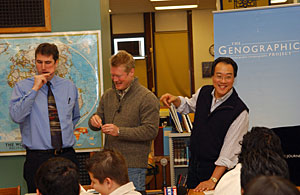Caputo’s career kaput
Looks like my shout-out last year to the world’s first female Italian-American in orbit will be my last for her. The press just loves the story of Lisa Caputo Nowak’s alleged melting-down over a love triangle — as though astronauts aren’t human. She’s an Italiana, fercrissakes! Of course she’s fiery!
I think it’s fair to say that she’s not going to pass the next pre-flight psych check. My guess.
If you’re catty in space, can anyone hear you growl?
UPDATE: And the whole fascination with wearing diapers for the long drive. C’mon, how do you think they spacewalk for 8 hours? She’s just used to efficiency.
Now this is winter!
How cold is it in Chicago?
- The midday, sunny high still has a minus sign in front of it.
- I thought my son was bleeding yesterday morning after I kissed him good morning. Only then did I realize that I cracked my freeze-dried lip open and bled on him in doing so.
- The city has a Blade Runner-esque look with every manhole and sewer drain belching steam. So noir!
- Loaning our shower to a friend whose hot water pipes — but not cold, huh? — froze solid.
- My son’s new favorite word is “negative.”
- It is too cold to snow.
- Shit-filled diapers freeze solid on the back deck instantly.
- The Bears have sucked all warmth from our hearts.
That’s how cold it is.
The (pāt’n) that matters
You know he’s watching. Go Bears!

“All four engines have failed”

I’ve been obsessed with plane crashes lately. No, obsessed isn’t right. Oppressed, maybe? I seem to be encountering information about air horror wherever I turn. Always nice before a series of trans-oceanic flights.
A few weeks ago I watched Superman Returns. The Man of Steel says to the passengers of a wingless jumbo jet he’s just safely landed, “I hope this incident hasn’t put you off flying. Statistically speaking it is still the safest way to travel.” It is a direct lift of a line Christopher Reeves also uttered in the original Superman from 1978. Certainly true, but for me it fails the truthiness test.
Then, as I babysat my computer during a marathon session of video rendering, aimlessly clicking through Wikipedia, I landed on Aviation accidents and incidents (part of the hell’s-gateway-esque Disasters Portal). Browsing through the air disasters really was like rubbernecking a car accident. I couldn’t turn away. I read every article in there. Airshow accidents, In-flight airliner explosions, Midair airliner crashes, Deliberate airline crashes, Fuel exhaustion on commercial airliners … the subcategories are scarily unique and many.
What you start to realize is: Damn, there are a lot of disasters where we don’t really know what happened. And then, once that’s sunk in: Damn, I’m surprised this doesn’t happen more often. There are some fascinating incidents. The jet that ditched in the Neva River in St. Peterburg, Russia without a single loss of life. The mentally-ill Japanese pilot who deliberately crashed on landing. And the worst of all collision of two 747’s on Tenerife in 1977.
Then — somehow, I wasn’t specifically looking — I stumbled upon this video of Boeing testing the structural limitation of the 777 wing. They found it. (And if I am ever in a plane with a wing bent like that I will have involuntarily evacuated my bowels well before structural failure, yessiree.)
Then yesterday, this story of a 747 that lost all four engines and actually landed safely. It is a terrifying tale. Again, I was not searching. I must be unconsciously sifting these things out of my feed reader or something.
And finally, gallows humor. This artwork/concept for a crash landing pillow that gives you the option of suffocating yourself before crashing. For the true control freak, you may now take charge of your own death, flaming airframe be damned. You know, it’s said that the only reason you’re told to put your head between your knees during a crash is so that your dental records stay as close as possible to the seat number for identification.
Anyway. Not sure what this obsession is all about. It would be one thing if I were actively hunting this information out, but I’m not. I feel like I’m in an M. Night Shyamalan flick.
I depart Monday.
Stirring the gene pool with a cello bow
There are days where my job is not much fun. Tuesday last week was not one of those days.
I spent the morning with Yo-Yo Ma and his Silk Road Ensemble paired with Dr. Spencer Wells of the Genographic Project. Actually, so did the student body of the Prosser Career Academy, a Chicago public high school on the west side. And this was all part of the Sister Cities Schools program.
Confused? It was a bit of a you-put-your-chocolate-in-my-peanut-butter event, but it actually worked. Sister Cities is a program that encourages multicultural exchange between the planet’s urban centers. Their new schools program extends this by putting students in contact from around the world. The Silk Road Project is a really interesting endeavor by Yo-Yo Ma to demonstrate the interplay of cultures via music, taking the ancient trans-Eurasia trade route as a metaphor for this journey. The Genographic Project in some ways has the same goals — a greater understanding of human diversity — but comes at it by seeking to more fully understand the patterns of human migration out of Africa by mapping genetic markers from people around the world. IBM’s life science group is providing the computational firepower for the massive amount of data that Wells and his team are collecting from the field.

Yo-Yo Ma is a huge fan of the Genographic project. In fact, I think he has a man-crush on Spencer Wells. Together they spoke to an AP History class and explained the goals of each project. The students were given genography kits to plot their own lineage on the world map and Ma played a short piece for the class, explaining the multiple cultural influences that coalesce in classical music. His specific example was how an African dance was incorporated in a piece he played by J.S. Bach.
The full Silk Road Ensemble then entertained an all-school assembly in between video clips of Spencer Wells traveling to crazy remote places to obtain information and blood samples from indigenes. At times the yoking-together of genetics and music seemed a bit forced, but it clearly can be done and does make some sense conceptually. Genetic proliferation and lingustic variation, for example, are tightly coupled; one offers insight where the other falls short. Will be interesting to see if Ma and Wells can uncover other points of intersection between the projects.
The students loved it all, actually. A teacher remarked that she’s never heard a full school assembly so oddly silent. I suppose everyone wonders where they come from, ultimately. One of life’s meta-questions.
See also: Macro-genealogy and A long walk out of Africa
Return to the Hermitage
My first major project when I joined IBM in 1998 pretty much changed my life. I was asked to lead the interface design of a new website for the State Hermitage Museum in St. Petersburg, Russia. The site was to be the public face for some three thousand newly-digitized high resolution scans of artwork. By most measures the site was a resounding success. At the time, and even for a few years afterwards, the site boasted the largest number of high-quality images on any museum website.

But web sites age quickly. Especially sites whose aesthetic impact is as important as its functionality. The site badly needs a facelift. So, in two weeks I’m headed back to St. Petersburg for the first time since 2000. It won’t be the massive overhaul that I undertook before, but I’m certain we’ll come up with something.
It’s strange thinking about returning to a place or project that was so formative to one’s career. You can obviously never go back. It is seven years on and I have an uneasy sense that I’ll be disrupting memories that have crystallized (probably falsely) into my own version of a Golden Age or a myth about the true beginning of my career. This all sounds flighty, I know, but there’s a part of me that wants to keep St. Petersburg associated with wide-eyed naivete and awe. Like not wanting to return to a special place from youth for fear of wrecking the memory of it by seeing it through adult eyes.
I dug up a long e-mail I wrote on one of my first trips to Russia. Here’s a taste (so to say) of the experience.
Call it snobby Americanism if you will, but I demand a positive ID on all soupy meat by-products prior to letting them circular-saw through my digestive system. I’ll drink most anything alcoholic, but, come on, don’t tell me that you opened the bottle of wine before you got to the table to save me the trouble — I can taste that it has been oxidizing in a warm room for about three months now. (Hell, I’ve made hooch that tastes like that.) Even the attempts at more traditional American junk food, which is fairly difficult to screw up, are mostly failures. For example, a waitress asked me if I wanted french fries with a meal the other night so I said sure. I was brought a platter of fries — as an appetizer, mind you — that were so disgustingly salty that my tongue began to wince before each fry reached my tastebuds. It was like magnetic repulsion or something. The fries looked like they had been dragged behind a car across the flats of Nevada. Then, in case I had not had my fill of this delicacy, my main meal arrived with a side order of fries. Thank god I had the refreshing bottle of flaccid wine to wash it all down.
Not exactly culturally sensitive*, to be sure, but also not a memory I want at all sullied by finer dining experiences this time around. I’ll gladly take the hyper-salted fries and a bottle of skunked wine.
[*] A few years after we launched the site, a paper appeared that claimed IBM’s work on the Hermitage site was a form of “cybercolonialism.” Say what you will about that, but the primary argument rested on IBM purportedly forcing the Hermitage to use American English rather than their standard British English. Whenever I read that I chuckle. You will too if can read and know the difference between ‘color’ and ‘colour‘.
Thamus (partially) vindicated
If you read yesterday’s post early in the day you may have missed that Richard Powers responded to it. I’m grateful for his very thoughtful reply. But what everyone wants to know is: how did he find the post? You mean, Richard Powers — MacArthur Genius, National Book Award Winner — reads John Tolva’s blog?
In a word, no. I e-mailed him and alerted him to the post. No buzz, no meme, no trackbacks, or digg swarms came to the attention of Mr. Powers. Just an old-fashioned note in his inbox that he graciously acted on.
Actually the story behind the reply is somewhat amusing. Powers initially commented but nothing showed up on the site. Usually that happens when the anti-spam script kicks in. But why would it block a regular comment? I was stymied and more than a little irked that this author had taken the time to respond and my site had black-holed his effort. And then it occurred to me that Powers was likely composing (or speaking) his response into an external application and then pasting it in-bulk into the blog comment form. This is a red flag for the spam script, since that’s exactly how bots dump garbage into blog posts, as a single pre-written chunk. I asked him to paste it in and then type a little at the end. You know, act like an old-fashioned human writer. Type a little. It worked. Congratulations, Mr. Powers. You appear to be human. Your comment shall be accepted. Turing test passed. (If you recall my in-person encounter with Powers you will find this as ironic as I do.)
Truth is, I’m more in awe of Powers’ talent than ever now that he’s erased any doubts I had about his composition-by-dictation (on a keyboardless machine — sheesh). I think my incredulity stems from the way I consider words spatially: objects on a page to be moved, sequenced, and arranged into thought. Almost like the visual arts. That’s a pretty narrow way to think about language, of course, but it has taken this little episode for me to realize just how much the tools of word manipulation I use form what I write. Perhaps even constrain what I write. I guess I need to fire up the speech reco on this MacBook and find out.
Speaking of, so to speak, it might be interesting to listen to The Echo Maker as an audiobook, if it exists. (Yikes, $120. What the hell?) Does it read out loud better because it was composed out loud?
If you are interested, here’s the tablet that Powers references in his reply. Litgeek!
One wonders what jacket-blurber and long-time Powers fan Sven Birkerts (of neo-Luddite Gutenberg Elegies fame) thinks of all this. The fate of writing in the electronic age!
By the way, if you liked The Echo Maker’s exploration of memory (and stories that begin with a mystery-shrouded car crash) you must read Michael Joyce’s seminal hypertext fiction afternoon, a story. A comparison of these two works would be interesting indeed.
Oh, and Prof. Turnbull you should engage Prof. Powers. If anyone can squeeze a publication from this, it’s you. 🙂
Thanks again, Richard!
Echoes and real voices
I recently finished the latest novel from Richard Powers called The Echo Maker. It was one of the finest books I’ve read in years. Powers is by leaps my favorite writer. His books are poems trapped in the novel form. The craft with words every bit as compelling as the stories they tell. I’m a big fan.
But there’s something different about this novel. It is still superbly crafted for sure, but the narrative engine revs louder. There was something about it. Something I couldn’t quite identify. As I was reading the book a fellow Powers fan friend of mine alerted me to an article in the NYT (login required), written by Powers, about how he composed the novel using only speech recognition software on a tablet computer. That was it, I thought. This must be the stylistic difference. A novel voice-crafted versus hand-crafted.
Except. The more I think about it, the more I can’t believe it. I work for IBM, a company deeply committed to speech recognition, text-to-speech, and machine translation. It is hairy, complex computing — bordering on AI. Personally I’ve been working in Arabic-English translation since 2000 and I know just how thorny the problems are in getting good recognition. I simply can’t believe an author as talented as Powers could create a book as linguistically complex as The Echo Maker using speech reco alone.
I’m not saying he’s lying. I’ve had some interaction with Powers, all positive. He kindly responds to e-mail, for one. And yet, there’s precedent for this tale of novel-by-dictation being fiction too. In 2002 at the Chicago Humanities Festival Powers delivered a talk called “Literary Devices” about an ELIZA-like machine that sucked him into an e-mail conversation that was as real as any human author’s output. I bought it. Most bought it. We bought wrong. The story itself was fiction — which only made it better. Humans falling for a story about a machine that tells stories indistinguishable from human stories. Amazing.
So, I guess I’m asking this. Mr. Powers, did you really dictate this whole novel? Or should we nestle comfortably in what is admittedly a damn good story even if you didn’t? All half-dozen readers of this blog are dying to know. And if we can’t tell your response from a computer impersonator we’ll obviously consider the dialogue valid. Do tell!
UPDATE: Powers replies. Wow. More on this in a bit …
See also the follow-up post Thamus (partially) vindicated.
Forward with backup
Is there any subject as thrilling as backup? Many– nay, most — in fact. But lately it seems like I spend at least as much time worrying about how to preserve my data as I do creating it.
I could create a rather interesting map mashup of all the places and ways my laptops have decided to crap out, so I’m more than normally concerned about comprehensive backup. But recently over the holidays I entered a whole new stratum of data management. I thought, gee, it would be nice finally to digitize all the family video we’ve had laying around since my first son was born in 2001. We’ve not been obsessive about videotaping family gatherings; we had only 20 tapes — few full — in six years. I thought, I’ll just whip up a quick DVD as a stocking stuffer for the wife. Idiot me. A full week later of nearly nonstop chip-searing rendering I had produced five full DVD’s of video. (And if I had heard another rendition of “Happy Birthday To You” I would have lost it.) It turned out well, though the data it produced was both priceless and ginormous.
So this added to a few of my backup needs, detailed here. Ideally I need to:
- Backup my main work laptop daily such that in the event of catastrophe I can boot from the backup image and resume work immediately.
- Backup two other essential machines in the house.
- Synchronize the main work laptop and a secondary work laptop. Oh, one is Mac OS the other is XP.
- Establish a schedule that includes local, accessible backup and offsite storage in the event of real catastrophe. (“Fire! Grab the kids … and the drives!”)
- Deal with the a massive music library and new half-terabyte of digitized video — offsite.
I’ve worked almost all of it out. For nightly backup I use SuperDuper! — a great app — to dump changes to a perfect image of my work laptop (a MacBook Pro) to an external, bootable Firewire drive.
The other machines in the house backup monthly to a networked Lacie drive.
I synchronize the MBP and ThinkPad using Apple’s smart folders, just copying over files from a Modified Since Last Backup folder to the ThinkPad. If you’ve ever used iTunes smart playlists you know how easy this is to set up. I suppose I could create an Automator action to do this automatically too, now that I think of it.
The last two present the problem. And this where I need your help. All told I have about a half terabyte of data to backup offsite, in case the shit really hits the fan. Time was, I’d just burn DVD’s and shuttle them to friends, family, or work. But I’ve surpassed the feasibility of burning DVD-R’s, HD-DVD storage is a a very rare thing these days, and the feasibility of online storage is hampered by cost and upload bandwidth. You’ll say, buy another external drive and move it offsite monthlyl! But I loathe to buy a fourth external drive in a calendar year. What to do?
The real problem is more philosophical. Backup to another device is relatively easy — and it is where most backup people do (if at all) stops. But to be truly comprehensive about it you need your backups in two different physical locations. Things happen. Robbery, fire, flooding. And this is where I am stuck. Help me, won’t you?
Monsters and Saints

Well, this is an interesting turn of events.
Like most anyone who came of age in Chicago in the 80’s I’ve been a Bears fan since their Super Bowl season under Ditka. I’m a fan. Not a die-hard who attends games shirtless in December, but a fan nonetheless.
Which is nothing compared to my wife’s family. Born and mostly raised in New Orleans, they are living caricatures of all-for-the-team dedication. The day I met the men who were to become my father- and brother-in-law — December 28, 1991 — was a Saints playoff game against the Atlanta Falcons — the result of the Saints’ first Division title ever. New Orleans came out strong but ended up blowing it.
I sat in wide-eyed horror as my girlfriend’s brother swore, stomped, threw things, and beseeched God to smite Jerry Glanville (then Atlanta’s coach) with a slow and painful death from cancer. My girlfriend’s father also was disconsolate and enraged, switching from cursing the TV to reprimanding his son not to wish death on anyone. It was a surreal event and one that would repeat itself in style if not in substance during innumerable other football games on which serious money rather than lifelong passion were wagered.
As a long-time Cubs fan I know the perverse pleasure that comes from loving a loser, so I have always respected — if not fully understood — my in-laws’ devotion to the Saints. I have in fact become something of a Saints fan vicariously. But as anyone who knows me or this blog, my heart is with Chicago always. I even mustered some pride when the White Sox won the World Series, I hesitate to type.
So, as Chicago barely squeaked into next week’s confrontation with New Orleans today I received a hug from my son who said “congratulations, Daddy.” I looked at him, looked at my wife shaking her head in anticipation of the inevitable, and said “son, you have one week to make a very serious decision about who you will cheer for next weekend.”
“Oh that’s easy,” he said. “Who dat!?”














